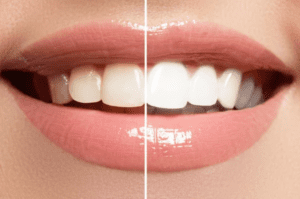Around the new year, many people decide to embark on journeys of personal wellness and gains. It is the time to change small habits or pieces of ourselves to become better versions of ourselves. An easy way to start the new year with a new you is to try a whitening treatment.

How Does It Work?
Most whitening treatments work the same way with the same chemicals. They target stains on the outer layer of your teeth—the enamel. Because it is the first layer, its job is to protect the delicate inner portions of your teeth. It is a whitish layer, so your diet and lifestyle can alter its color easily. For example, smoking cigarettes or drinking coffee every day can cause your teeth to turn yellow.
While some staining is not detrimental to your teeth, many people prefer a bright white smile. As a result, they look for different whitening treatments. Many at-home treatments use chemicals to lift the stains from the teeth. Mainly, these chemicals are hydrogen peroxide and carbamide peroxide.
To get rid of stains, these chemicals create a chemical reaction that breaks them down. This is how whitening treatments lift the shade of your teeth; they chemically deconstruct the stains.
Some whitening treatments, like toothpaste, use abrasives to scrub away the stains. When you go to the dentist for a dental cleaning, you get a similar treatment. To polish your teeth, they use a high-powered brush and a gritty toothpaste. You may notice a slight lift in the shade of your teeth.
What are the Effects?
Because whitening treatments use chemicals, you are likely to experience a range of effects.
Increased Sensitivity
While your enamel is incredibly strong, it is a porous substance. This is how stains can enter your tooth in the first place. These pores allow the peroxide chemicals to break down and lift the stains. Unfortunately, hydrogen peroxide and carbamide peroxide can cause sensitivity in your teeth.
This means that consuming foods or drinks that are hot or cold can cause mild pain or irritation. Normally, the sensitivity won’t last long. It is a short-term side effect of the whitening chemicals. If you do suffer from sensitivity, you can use a toothpaste formulated for sensitivity.
Gum Irritation
Whitening treatments must remain on your teeth. They are designed to stay on the enamel, which is the strongest tissue in your body. When the chemicals touch the soft tissues of your gums, they can cause irritation. This can range from redness to sensitivity.
One way to avoid gum irritation is to keep the chemicals from touching your gums. If you do, you should wipe the whitening treatments from your gums as soon as possible.
Bright, White Smile
The negative side effects of whitening treatments are generally mild. This means that they are unlikely to interrupt your day-to-day life, and they won’t last long.
You will probably notice a brighter, whiter smile over the course of several weeks. Of course, a dazzling white smile is likely the reason that you decided to try a whitening treatment in the first place.
